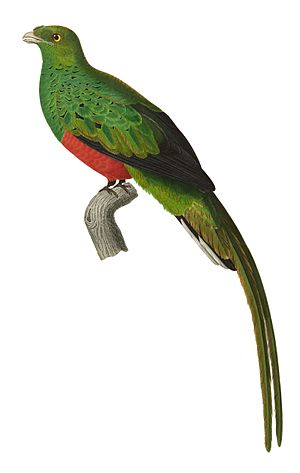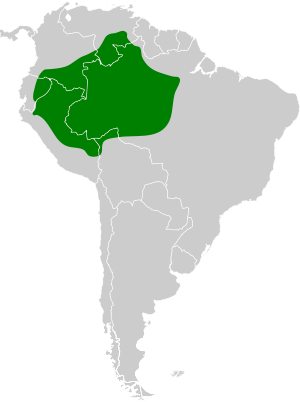Pavonine quetzal facts for kids
Quick facts for kids Pavonine quetzal |
|
|---|---|
 |
|
| Conservation status | |
| Scientific classification | |
| Genus: |
Pharomachrus
|
| Species: |
pavoninus
|
 |
|
The pavonine quetzal (Pharomachrus pavoninus) is a beautiful bird from the Trogonidae family, also known as trogons. People sometimes call it the peacock trogon or red-billed train bearer. In Spanish, it's called viuda pico rojo. This amazing bird lives in the Neotropics, mainly in the northern part of the Amazon rainforest. You can find it from Colombia all the way to Bolivia.
You can easily spot a pavonine quetzal by its bright feathers and its red beak (males have red beaks, females have grey ones). It's also special because it's the only quetzal that lives in the lowland rainforests east of the Andes mountains.
Contents
What is a Pavonine Quetzal?
The pavonine quetzal belongs to the Trogon family. Trogons are unique birds because of how their toes are arranged. Unlike woodpeckers, which have two toes pointing forward and two backward, trogons have their first and second toes pointing backward. Their third and fourth toes point forward.
This special toe setup means trogons are not very good at walking or hopping. So, you'll usually see them flying or resting on branches. Many trogons, like the famous resplendent quetzal, have developed long, fancy feathers. This shows that they don't need to be the best fliers.
Trogons usually fly short distances with quick, wavy wingbeats. Because they don't fly very efficiently, they don't migrate far, if at all. However, you can find different kinds of trogons all over the world in tropical areas. They live from sea level up to 3500 meters high. Most trogons eat mainly fruit, insects, or a mix of both.
Quetzals: A Special Kind of Trogon
Within the Trogon family, there are two main groups. One group is the African trogons. The other group includes trogons from Asia and the Americas. Pavonine quetzals are part of the group called "New World trogons" and quetzals.
Quetzals, which belong to the genus Pharomachrus, are different from other New World trogons in a few ways. Their nostrils are closer together and partly hidden. Quetzals are also quite heavy, weighing about 150 to 250 grams. They mostly eat fruit. Male quetzals have four long, shiny feathers on their upper tail that often extend past their main tail feathers.
What Does a Pavonine Quetzal Look Like?
Like many quetzals, pavonine quetzals are very colorful. Males and females look a bit different, with females being less bright. They look most like the golden-headed quetzal (Pharomachrus auriceps).
Male Pavonine Quetzal
Male pavonine quetzals have shiny green feathers on their back, chest, and upper tail. These feathers can sometimes have a bronze edge. Their head feathers look golden brown to golden green. Their belly is a bright red color.
The rest of their wing feathers, tail feathers, and thigh feathers are black. Their beak is red, matching their belly, and turns yellow at the tip. Their eyes are reddish to brownish, and their legs and toes are yellowish to brownish.
Instead of feathers on their forehead, males have bristly feathers on the back of their neck that form a small crest. The longest feathers on their upper tail are long and pointed, often covering most of their tail.
Female Pavonine Quetzal
Female pavonine quetzals are similar to males but their colors are not as bright. Their head is brown or greyish. Their beak is mostly grey with a black tip. The tips of their wing feathers are more buff-colored, and their belly is a brownish-red.
Female tail feathers have a pattern of black and white bars. Their upper tail feathers are also shorter than those of the males.
Where Do Pavonine Quetzals Live?
Pavonine Quetzal Distribution
The pavonine quetzal lives all year round in the Amazon basin. You can find it across the borders of Brazil and Venezuela, southeastern Colombia, eastern Ecuador and Peru, and northern Bolivia. For example, they are in the states of Amazonas and Bolívar in Venezuela. They are also in Amazonas and Roraima in Brazil, and Beni and Pando in Bolivia.
These birds tend to avoid certain areas like the Tapajós River in the southeast, the Orinoco River in the north, and the Andes mountains in the west. Most of them live between 10°N and 15°S latitude.
Pavonine Quetzal Habitat
The pavonine quetzal is the only quetzal found in the lowland rainforests of South America east of the Andes. They prefer to live in the "terra firme" forests, which are forests that don't flood, found in the Amazon basin.
Within these forests, they usually stay in the lower and middle parts of the understory. They can be found anywhere from 250 meters to 1200 meters above sea level. Some reports say they live at even lower elevations, from sea level to 700 meters. They mostly stay in trees and only sometimes come down to the forest floor.
Pavonine Quetzal Behavior
The pavonine quetzal is not a very well-studied bird. This means we don't know a lot about its behavior. A few studies have included this quetzal in bird lists, but they rarely go into much detail about how it lives.
What Do Pavonine Quetzals Eat?
Like most quetzals, P. pavoninus mainly eats fruit. One study looked at the stomach contents of nine of these birds. Eight of them had only eaten various fruits. The ninth bird had eaten a mix of fruits and insects. Other researchers have seen similar behavior, calling them fruit-eaters.
In 2007, a report described how a pair of pavonine quetzals fed their newborn chick. Right after hatching, about half of the young bird's diet was tree frogs. The other half was different kinds of fruit. The tree frogs were mainly from two groups: Hyla and Phyllomedusa. The fruits came mostly from Lauraceae trees. Other fruits were from Euterpe precatoria, Iryanthera sp., Pouteria sp., Guatteria and Unonopsis sp., and Tetragastris sp. As the chick grew, its parents fed it more and more fruit.
Pavonine Quetzal Calls
Quetzal calls are usually simple, loud, and repeated. The pavonine quetzal's call sounds like a descending whistle, like "ew ewwo ewwo ewwo ewwo." This is often followed by a "chok" note. They repeat this call about four times in ten seconds. This is their most common call.
They also make an alarm call that sounds like a chattering "wa op-op-op-op," similar to a woodpecker. Young quetzals can only make a short "ow" sound. These calls seem to be the same for both males and females. They are especially common during mating season. For example, males often call repeatedly to show where they are after finding a good nesting spot.
Reproduction and Life Cycle
There is still much to learn about how pavonine quetzals breed. We don't know a lot about their visual displays or vocal calls during courtship. However, it seems that breeding involves chasing each other. They also do some visual displays while perched or flying. Both birds also make calls to each other.
These birds appear to be monogamous, meaning they stay with one partner. They work together to dig out their nest. They choose nesting spots in rotting trees, old woodpecker holes, or even wasp nests. They add little to no soft material inside the nest. Nests have been found between 4 and 9 meters above the ground.
One confirmed report of a pavonine quetzal nest described it as a hollow, mostly empty space. It was deep enough to hide both adult birds. The entrance was round or wedge-shaped. The report also said the nest had two eggs, which is typical for this group of birds. The eggs were pale blue with a few light brown speckles. They weighed between 8.5g and 13.5g and measured about 27.6-28.1mm by 31.5-32.4mm.
Both male and female quetzals help incubate the eggs. Males usually incubate during the day, from about 10 AM until sunset. Females incubate overnight and in the early morning. The eggs hatch after at least 14–17 days. Once the eggs hatch, the adults spend less time in the nest. The male usually brings food to the young, but both parents care for them.
The baby quetzals are born helpless and depend heavily on their parents for food. This continues even after they leave the nest. They stay in the nest for about 21 days. After leaving the nest, they depend on their parents for up to two months. During this time, the parents feed them on the ground or on low branches. Young chicks are most at risk from predators like raptors, snakes, and squirrels during this period.
Their feathers take a few weeks to fully grow. They start with soft, down-like feathers and eventually grow their full juvenile plumage. Young birds look quite different from adults at first. For males, it's thought that it takes up to three years for their full adult feathers to grow in.
Images for kids
See also
 In Spanish: Pharomachrus pavoninus para niños
In Spanish: Pharomachrus pavoninus para niños



